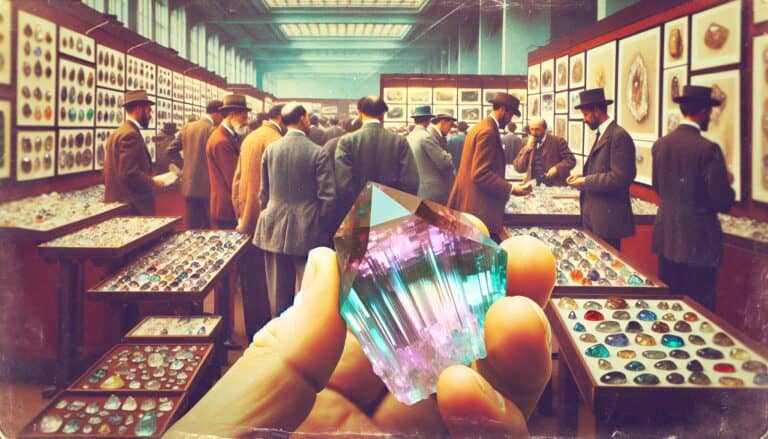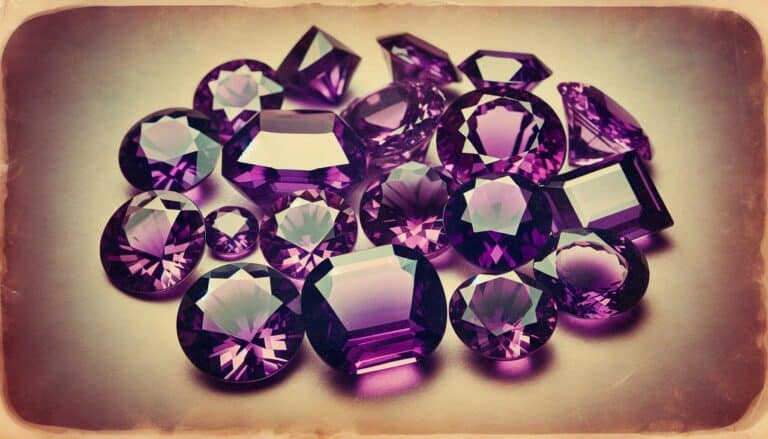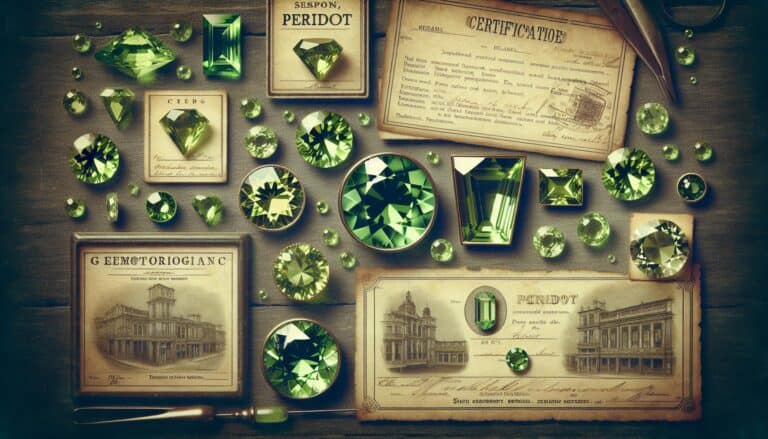Discovering the serene beauty of celestite is like uncovering a hidden gem of the mineral world.
You’re about to learn how to identify this captivating stone, prized for its heavenly blue hue and ethereal qualities.
You’ll find out that celestite isn’t just a feast for the eyes; it’s also a treasure trove of characteristics that make it stand out. Knowing what to look for will turn you into a celestite-spotting pro in no time.
Ready to embark on your celestite journey?
Let’s dive into the telltale signs that’ll help you distinguish this celestial mineral from its earthly counterparts.
To identify celestite, look for its pale to sky-blue color, tabular or prismatic crystals, and translucent to transparent quality. It’s non-magnetic, with a Mohs hardness of 3-3.5, shows birefringence, single refraction, and has a refractive index of 1.622-1.632. Its specific gravity ranges from 3.95 to 4.03.
How to Identify Celestite Through Testing
When admiring the beauty of celestite, you’ll find that it’s not just its striking blue color that sets it apart. Various tests can be employed to confirm the identity of celestite specimens. These methods can help you differentiate celestite from similar-looking minerals and ensure that you have an authentic piece.
Visual Inspection
First, consider the color and crystal form of celestite. Look for a pale blue to sky-blue color, though some specimens may appear colorless or have hues of white, pink, or green. Celestite crystals often form in tabular or prismatic shapes, sometimes occurring in geodes or clusters. Examine the crystal faces; they should exhibit a vitreous to pearly luster.
The Streak Test
The streak test helps determine the color of a mineral in powdered form, which can be different from the surface color. Drag your celestite gently across an unglazed porcelain streak plate. Expect to see a white streak, indicating the purity of the mineral and ruling out the possibility of dyed impostors.
Magnet Test
Celestite isn’t magnetic, so if you hold a magnet near your sample and notice any magnetic attraction, you might be dealing with another mineral. For celestite, there should be no reaction to the magnet.
Hardness Test
You can gauge celestite’s hardness using the Mohs scale. Celestite ranks at a 3-3.5, which means it can be scratched by a penny but not by your fingernail. It’s a relatively soft mineral, so take care when performing this test.
Birefringence Test
Birefringence is the optical property of a material having a refractive index that depends on the polarization and direction of light passing through. Use a petrographic microscope to observe this phenomenon. Celestite will show birefringence, which you’ll note as a change in color or shade when the crystal is rotated under polarized light.
Checking The Diaphaneity
Assessing celestite’s diaphaneity—or the degree to which light passes through it—can aid in identification. Look for transparency to translucency in your samples, as celestite allows light to pass through, albeit not as clearly as a crystal like quartz.
Single or Double Refraction
While performing the diaphaneity test, also check for single or double refraction. When you place a dot underneath the mineral, if celestite is present, you’ll see just one clear dot, indicating single refraction due to its isotropic nature.
Refractive Index Test
To measure the refractive index, you’ll need a refractometer. Celestite typically has a refractive index ranging from 1.622 to 1.632. Precise measurements can help confirm the mineral’s identity, especially when cross-referenced with other properties.
Finding The Specific Gravity
The specific gravity test involves measuring the density of your specimen. Celestite’s specific gravity usually falls between 3.95 to 4.03, which is higher than many common minerals. This test often requires specialized equipment to achieve an accurate reading.
Identifying Celestites in the Field
In the field, you’re likely to encounter celestite in sedimentary rock deposits, especially areas known for gypsum or limestone. If you’re in regions with a geological history of evaporite deposits, keep your eyes peeled for this delicate mineral.
Recognizing Potential Celestite Rocks
Look for rocks with telltale signs such as blue coloration, crystal structure, and associated minerals. Keep in mind that celestite often resides near other sulfate minerals, which can help you home in on finding authentic celestite specimens.
Physical Characteristics of Celestites

When you’re identifying celestite, physical characteristics are your first point of reference. Recognizing these features is crucial to distinguish celestite from other minerals. Pay attention to the crystal habit: celestite typically forms in well-defined, tabular or prismatic crystals. They possess a vitreous to pearly luster that makes them stand out when light reflects off their surfaces.
An important characteristic to note is the mineral’s color. Celestite commonly displays a range of hues, from colorless to shades of blue, and less frequently, reds, pinks, and greens. Its most iconic color is a pale blue, which is caused by trace amounts of strontium within the mineral.
The mineral’s transparency varies from transparent to translucent, and in exceptional cases, you might come across specimens that are nearly opaque. Breaking celestite will show you its perfect cleavage in two directions, revealing flat, shiny surfaces.
Don’t forget to consider the mineral’s streak. When you scrape celestite across a porcelain streak plate, it leaves a white streak regardless of the specimen’s color. This trait is a telltale sign when you’re in the field and need a quick way to verify your find.
The specific gravity of celestite also sets it apart. Although you may not be able to measure this in the field, knowing that celestite has a specific gravity of about 3.95 to 4.03 can help confirm a specimen’s identity when you have access to the right tools.
| Property | Value |
|---|---|
| Crystal Habit | Tabular, Prismatic |
| Color | Colorless, Blue, Reds, Pinks, Greens |
| Luster | Vitreous to Pearly |
| Transparency | Transparent to Translucent |
| Cleavage | Perfect in Two Directions |
| Streak Color | White |
| Specific Gravity | 3.95 to 4.03 |
Remember these physical characteristics during your next mineral hunting escapade. Each feature you recognize gets you closer to accurately identifying whether the stone you’re examining is truly celestite. Keep this guide handy, and with practice, you’ll become proficient at distinguishing this remarkable mineral.
How Are Celestite Formed?
Understanding the formation of celestite will enhance your ability to identify it. Celestite, or strontium sulfate (SrSO4), typically crystallizes within sedimentary rocks. These rocks include limestone and gypsum formations where conditions are favorable.
The process begins millions of years ago, as sea water evaporates and leaves behind strontium-rich sediments. Over time, these sediments, under the right conditions of pressure and temperature, transform into celestite crystals. Additionally, hydrothermal processes can also contribute to celestite formation. Here, mineral-rich fluids percolate through rock layers, depositing celestite in cavities or fractures.
Most celestite forms in geodes or as isolated crystals. You’ll often find it in association with other sulfate minerals such as gypsum and anhydrite. The size and purity of the crystals depend on the conditions during their formation.
Areas rich in celestite often have a history of evaporation cycles, such as ancient seabeds or lake bottoms. Dry, arid climates are prime locations where you may discover this mineral. Look for regions with known sedimentary rock formations and you’ll increase your chances of finding celestite.
Preparation for Celestite Hunting
Gathering the Right Tools
Before setting out on your celestite hunting adventure, you’ll need to ensure you’ve got all the right tools. High-quality equipment can make the difference between a fruitful excursion and a frustrating one. Here’s what you should pack:
- Geologist’s hammer: This is essential for breaking open rocks and geodes where celestite crystals may be hiding.
- Hand lens or magnifier: These tools will help you examine potential finds on a micro level.
- Sturdy gloves: Protect your hands from sharp rock edges and rough surfaces.
- Safety goggles: Always shield your eyes when chipping away at rock formations.
- Durable backpack: You’ll need something to carry your tools and any specimens you may find.
- Field guidebook: A guide can assist in identifying celestite and other minerals in the field.
Remember, investing in quality gear pays off in the long run and can greatly enhance your experience.
Safety Considerations
Your safety should be your top priority during celestite hunting. The areas where you’re likely to find these crystals can pose various risks. Keep these tips in mind:
- Check the weather forecast: Don’t get caught in extreme conditions.
- Inform someone of your whereabouts: Always let a friend or family member know where you’re going and when you expect to return.
- Bring sufficient water and snacks: Stay hydrated and energized during your search.
- Dress appropriately: Wear long pants and sleeves to protect against scrapes and cuts.
- Carry a first aid kit: Be prepared for minor injuries that could occur while hunting for celestite.
- Be aware of your environment: Steer clear of dangerous terrain and be cautious when using tools.
Adhering to these safety practices helps ensure you enjoy your celestite hunting expedition and return home with great finds and even better memories.
Handling and Care of Found Celestites

Once you’ve successfully located and extracted celestite specimens, it’s crucial to handle them with great care to maintain their natural beauty and value. The following guidelines will help you keep your finds in pristine condition.
Cleaning Celestites
When you’re back from your hunting trip, you’ll want to clean the celestite crystals gently to reveal their true color and form. Begin by using a soft brush to remove loose dirt and debris. If the specimens are particularly dirty, you may need to soak them in water. Follow these steps for a thorough clean:
- Rinse under lukewarm running water to wash away smaller particles.
- Soak in a container with warm water and a mild detergent for about an hour.
- Use a soft-bristled toothbrush to gently scrub the celestite.
- Rinse again with clear water to remove any soap residue.
Take care not to use any harsh chemicals or abrasive materials that could scratch or damage the delicate crystal structure. After cleaning, pat the celestites dry with a soft cloth and allow them to air dry completely before storing.
Storing Celestites
Proper storage is just as important as cleaning to ensure your celestites remain intact. Avoid exposure to direct sunlight, which can fade the color over time. Here’s how to store your celestite crystals to protect them:
- Wrap each crystal individually in a soft cloth or place them in a padded container.
- Use a compartmentalized box if you have multiple pieces to prevent them from rubbing against each other.
- Store in a cool, dry place to avoid any deterioration due to humidity.
By caring for your celestite crystals properly, you’ll keep them in top condition, preserving their aesthetic appeal and metaphysical properties. Whether you’re a collector or a crystal enthusiast, handling and storing your celestite with care is key to enjoying your finds for years to come.
Conclusion: Confirming Celestites Real
You’ve now got the knowledge to confidently identify celestite and ensure its longevity with proper care.
Remember to handle your crystals gently and store them with the care they deserve. By following the simple steps outlined, you’ll keep your celestite’s vibrant glow and energy intact.
Enjoy the beauty and tranquility of your celestial find, a true treasure of the natural world.




![South Dakota Rockhounding Sites in [year]](https://observationhobbies.com/wp-content/uploads/2024/01/kNC8Njq0n49hZutA6mi-768x439.jpg)


